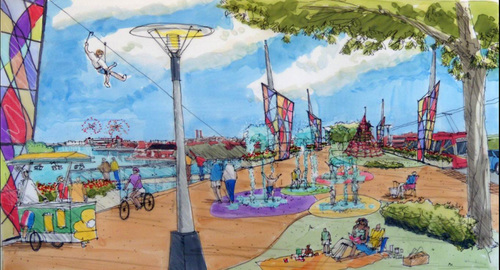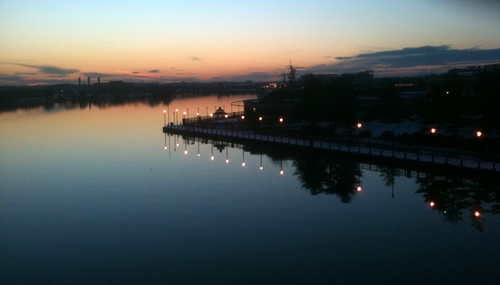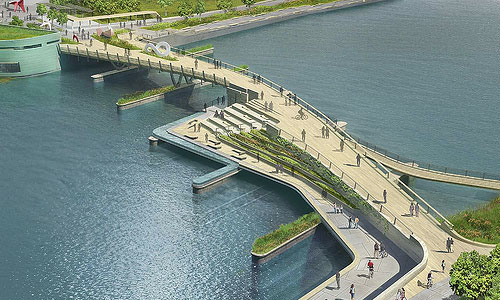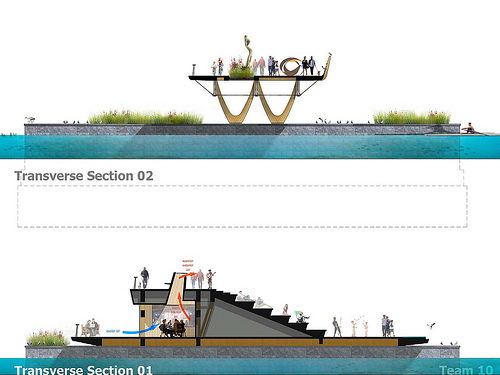Design could make or break the 11th Street Bridge Park
Washington has long turned its back on the Anacostia River, and in turn the neighborhoods east of the river. The 11th Street Bridge Park could become one of the city’s most distinctive places, turning disused bridge structures into a connector and destination. With a design competition now underway, all that’s left to do is design and build it.
That’s a tall order, but the project was born out of ingenuity. The proposed park takes advantage of foundations left over from one of the 1960s highway bridges. Rather than connect Capitol Hill to Anacostia, the highways isolated both.
Originally intended to feed the inner loop freeway, the old bridges were great for driving through the riverfront neighborhoods on the way to something else. When the city rebuilt the bridges in 2012, the city was left with an obsolete, but not totally useless, bridge next to the new local span.
The possibility of doing something with the remnants stuck in the mind of Scott Kratz, who at the time worked at the National Building Museum. At a meeting with then-Office of Planning director Harriet Tregoning, he brought up the concept of reusing the bridge. To his surprise, she immediately thought it was a great idea.
Since then, Kratz has been figuring out the details and building support for the Bridge Park, now working full-time on this project at THEARC in Congress Heights. That organization has held 195 meetings on both sides of the river to find out what the bridge would need to be, with a focus on reaching out to residents who often feel ignored in efforts to improve the city.
Now, THEARC and its appropriately named parent organization, Building Bridges Across the River, are looking to open the dialogue to everyone who benefits from the Anacostia. Since the park will likely be privately funded but publicly owned, raising the $35 million required to build and endow the bridge park will be a major goal. The other key part will be a design competition.
The Bridge Park must be more than a park
Given the precarious site and high cost, this project is risky. Getting the design right can make all of the difference between a world-class park and a white elephant, as Dan Malouff has previously noted.
Rather than stage an ostentatious open competition where flashy, iconic images predominate, Kratz went to the communities first. Some of those 195 meetings were charrettes, design meetings where stakeholders identified what was missing from their neighborhoods and how the bridge could fix them. When professionals do get involved later this month, they’ll be screened based on their experience working with communities as much as design skill.
Participants in the outreach meetings have focused on a few ideas for the park again and again. Because the East of the River neighborhoods face high obesity and hypertension rates, active recreation figures prominently in visions for the park. This includes playgrounds, as well as conventional sports areas, since there isn’t one in Anacostia proper. In a similar vein, the Bridge Park staff are interested in introducing urban agriculture to the bridge, possibly fruit trees.
Encouraging residents to interact with the river is another goal. This might mean a dock as much as a environmental education center. Artistic output forms the final side: an outdoor performance space, or even a facility for an arts nonprofit could be part of the project. In general, Kratz sees art as crucial to letting the community take ownership of the park when it opens.
Turning the site’s challenges into opportunities
I would like to see programs that take advantage of the elevated site. Since it’s not an automobile bridge, the Bridge Park doesn’t need to be flat, symmetrical, or even the same width all the way across. A skate park might suit the site perfectly. It’s a loud activity that needs uneven terrain to play up its acrobatic elements.
Urban agriculture, on the other hand, seems counterintuitive. Planting beds would require importing large volumes of dirt and building a heavy-duty structure to support it. There are sites in Anacostia on actual land that seem more obvious for a farm.
The main challenge the site faces is its isolation from busy streets. The first piers of the Bridge Park are ¼ mile from Good Hope Road on one side. On the other side, M Street SE is a long walk along the Navy Yard’s fences and a highway viaduct.
Kratz realizes this problem, so he worked with students from Virginia Tech to find every possible connection, especially to the Anacostia Riverfront Trail. They proposed lighting and community art to enliven the sidewalks to M Street and Good Hope Road. Arriving with a gym bag might still present an obstacle, so Kratz is working with DDOT to install a stop for the Anacostia streetcar, which will run over the new bridge.
Streetcar access will be the most important factor in drawing residents to the active recreation sites. For casual recreation, how the designers locate activity areas could make those walks easier. With major attractions at either abutment of the bridge, visitors would come to pick up their kid from an event and kill time by talking a walk down to see the great view downriver.
Bridge Park needs to feel like a place to succeed
These designers will face a site pretty much unlike any other. Journalists frequently compare the Bridge Park to New York’s High Line, but there are several crucial differences. For one, the High Line runs for 1.45 miles through dense neighborhoods, well connected to the streets below.
Reusing the entire structure of an old railroad viaduct, the High Line was stuck with relatively tight dimensions, ranging from 30 to 88 feet. That’s about size of a tennis court. The 11th Street Bridge Park has the potential to stand 160 feet wide and 800 feet long, around the size of three professional football fields end-to-end.
And pedestrian bridges sometimes have places to rest, but they rarely are destinations by themselves. There are a few unbuilt parallels, like Thomas Heatherwick’s Garden Bridge in London, or OMA’s
Jean-Jacques Bosc bridge in Bordeaux, but those still function primarily as transportation infrastructure.
There is one project that has actually gets beyond the transportation deck: a pedestrian bridge in Providence. Reusing the piers of what had been a highway bridge right through the center of town, the new bridge connects two sections of a greenway.
Architect inForm and engineer Buro Happold created a structure that varies width and height: In one place, a delicate bridge, while on the other, it’s grassy steps down to the river. With all of this three-dimensional variation, the designers were able to put a café in the middle.
What’s nice about the Providence project is that it looks a lot like a street: it has the multi-layered activity that happens when people are passing by, relaxing, working, and working out. To be successful, the Anacostia Bridge Park needs to sustain this kind of activity. The design of the project, from how the activities are arranged to the way it interprets the river artistically is what will do that.
The designers’ test will be to take the communities’ desires and layer them within architecture that connects the mundane to something bigger in the context. In other words, the park should make a basketball game feel as connected to MLK Boulevard as to the flow of water underneath. The players should sense that they’re playing 20 feet in the air and a mile from the Capitol.
The bridge park can’t solve that many problems. But it can create a place of confluence between the city’s different constituencies. If everyone feels they own this park, it can be part of a more inclusive revitalization of Washington.
To find out more about the Bridge Park, please visit bridgepark.org. The design competition will be announced on March 20th.






